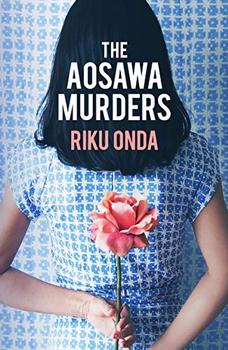- first published in Japanese in 2005 as Eugenia
- first published in UK by Bitter Lemon Press in 2020
- translated from Japanese by Alison Watts
- 315 pages
- ISBN 978-1-912242-24-5
Synopsis (Bitter Lemon Press)
The Aosawa Murders won the 59th Mystery Writers of Japan Award for Best Novel.
The novel starts in the 1960s when 17 people die of cyanide poisoning at a party given by the owners of a prominent clinic in a town on the coast of the Sea of Japan. The only surviving links to what might have happened are a cryptic verse that could be the killer's, and the physician's bewitching blind daughter, Hisako, the only person spared injury. The youth who emerges as the prime suspect commits suicide that October, effectively sealing his guilt while consigning his motives to mystery.
The police are convinced Hisako had a role in the crime, as are many in the town, including the author of a bestselling book about the murders written a decade after the incident, who was herself a childhood friend of Hisako’ and witness to the discovery of the killings. The truth is revealed through a skillful juggling of testimony by different voices: family members, witnesses and neighbors, police investigators and of course the mesmerizing Hisako herself.
The Aosawa Murders takes the classic elements of the mystery genre but steers away from putting them together in the usual way, instead providing a multi-voiced insight into the psychology of contemporary Japan, with its rituals, pervasive envy and ever so polite hypocrisy. But it’s also about the nature of evil and the resonance and unreliability of memory.
My Take
This novel has the reader working hard to cope with both the structure of the novel and the author's intent. It appears to be first of all a series of interviews, three decades after the original poisonings, presented as one-sided conversations with a range of "witnesses", where we can only surmise what the original questions were. In the main those being interviewed are being asked about an event that took place over 30 years before, when 17 people died of cyanide poisoning at what was meant to be a double birthday celebration. Of the actual family only one child, a blind girl, is left. She did not drink any of the sake or cordial that contained the poisoned but sat listening to those around her vomiting and dying in agony.
At the time the blame was pinned on a young man who committed suicide a few months after the event, but there did not seem to be any motive. In the absence of real clues the original detective became convinced that the surviving daughter was somehow responsible even if she wasn't the one who delivered the poisoned liquids. Later other survivors were also apportioned blame.
I think Japanese crime fiction is quite markedly different from that which I usually like to read. It appears that Japanese crime fiction readers like to have their plots more inconclusive, more focussed on the psychological, more open-ended. While other blurbs and reviews tell us that the plot is finally resolved, that the murderer finally becomes clear, I don't think that is the case. Maybe I just missed the bit that proved conclusively "who dunnit" but I didn't think, at the end, that it was clear - in the final wash-up we were still in the area of theory, hence my final rating. You, of course, may disagree totally.
I'd like to note also how long it has taken for this title to be translated into English. I'm not sure we can read anything into that apart maybe from recognising that maybe 15 years ago readers in English would not have been so accepting of this type of crime fiction.
My rating: 4.2
About the author
Riku Onda, born in 1964, is the professional name of Nanae Kumagai. She has been writing fiction since 1991 and has won the Yoshikawa Eiji Prize for New Writers, the Japan Booksellers' Award, the Mystery Writers of Japan Award for Best Novel, the Yamamoto Shūgorō Prize, and the Naoki Prize. Her work has been adapted for film and television.

No comments:
Post a Comment